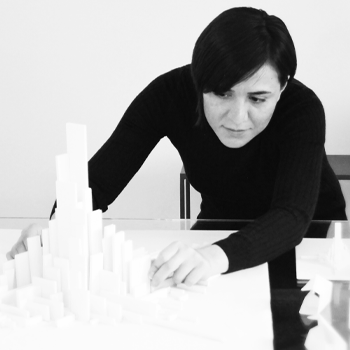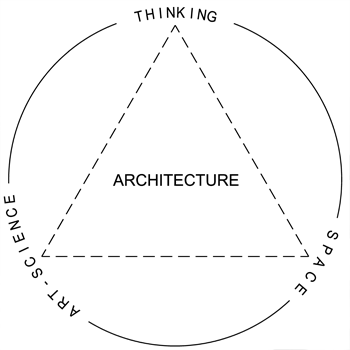 We always think where should we start with an architectural project. It obviously comes from the education, experience and the life that we had to date. So, memories of knowledge, places, materials and people are the core in start of our thinking process. We couldn’t identify since when these memories started to shape back in our lives. From a happy childhood to a vigilant teenage time to an architectural professional life in three continents, all have helped to shape what we can do today. The end result usually is a space with floor, walls, ceiling and openings with light and air flow. Sometime the ceiling is sky and we have an open to sky space, or sometimes the walls are made by bi-fold panels that open and stretch the space to the outside. Yet, the space has a scale and a feeling. The scale of the space and the feeling in it are different based on the program and the need of the project. What is identical is the memories that the space is making for its occupants. The scale of the space comes from the type of the building and its feeling comes from the space specifications. Furniture, colors, materials, window shape, technology and all other specifications form the feeling of a space. They are all different from one project to another. The importance of our architecture is that the spaces we make are going to be lived in for a while making memories. we believe this is what makes the architecture an “Artistic Science” for a thing. It is neither art-only nor science-only. It is art and science together with so many complications, parameters and technicalities.
We always think where should we start with an architectural project. It obviously comes from the education, experience and the life that we had to date. So, memories of knowledge, places, materials and people are the core in start of our thinking process. We couldn’t identify since when these memories started to shape back in our lives. From a happy childhood to a vigilant teenage time to an architectural professional life in three continents, all have helped to shape what we can do today. The end result usually is a space with floor, walls, ceiling and openings with light and air flow. Sometime the ceiling is sky and we have an open to sky space, or sometimes the walls are made by bi-fold panels that open and stretch the space to the outside. Yet, the space has a scale and a feeling. The scale of the space and the feeling in it are different based on the program and the need of the project. What is identical is the memories that the space is making for its occupants. The scale of the space comes from the type of the building and its feeling comes from the space specifications. Furniture, colors, materials, window shape, technology and all other specifications form the feeling of a space. They are all different from one project to another. The importance of our architecture is that the spaces we make are going to be lived in for a while making memories. we believe this is what makes the architecture an “Artistic Science” for a thing. It is neither art-only nor science-only. It is art and science together with so many complications, parameters and technicalities.
Both of us have lived in three major cities in our lives. We’ve learnt that spaces come together to shape a building and buildings come together to shape cities. Whether it is Urmia in Iran, Melbourne in Australia or New York in United States, this fact is true for all of them where our memories are made. What is different though is in “How”. We think “how the spaces come together to shape a building” is the point that makes Urmia, thousands of years old city, different to Melbourne, a very well-planned growing city, and New York, a mega city with complex infrastructures. The purpose here is not to compare these cities. Yet to express our reads of the “How” from living in them. We should say that this “How” is not a normal and simple “How”. It is for “how architects”, “how clients”, “how contractors”, “how engineers”, “how authorities”, “how technology”, “how transport”, “how climate”, “how soil”, “how materials”, “how culture”, “how economy”, “how politics” and “how people” can make spaces come together to shape buildings to shape cities. And we are afraid we are missing so many other “How”s. Yes, architecture is a complex profession when we look at it professionally regardless of progresses in time and technology. But the joy is, we think, how to make this array of complexities; a simple, easy to understand and noble process.
Economy of a city is the second factor that usually comes after its People. Yet, economy in a city is not easy to explore as there are cultural, educational, residential, political, commercial and so many other derivatives to be studied. And our expertise is not in economy but in architecture. When it comes to architecture, we can argue that for many reasons architecture of buildings has direct and indirect impacts on economy of cities. Urban planning for sure deals with formation of cities in larger scale. Yet the blocks are made by buildings and their architectures. Sometimes architects think as urban planners and their art creates harmony in city fabric. If this city image is likeable or not is not our argument here. Our point is in diversity that is made in different cities. In overall, our experiences tell us that great architecture makes great cities that produce great economies. To particular, New York is a perfect example. Whether it is museums that generate revenue for tourism, education system that gets local and international students for schools and universities, hotels that generate revenue in travelers’ accommodations, condominium-co ups-rental buildings that generate money for real estate – construction and maintenance industries, the transport system that generates money for airports, cruise ships, trains, subways, buses, taxis and other transport means,  UN Building that gathers world leaders on yearly basis to talk about the universe, or the restaurants and food industry, hospitals and clinics that deal with health services, courts and lawyer offices that support justice system, banks and insurance companies for financial industries, energy power plants and city operations that provides business for public services, and so many other city infrastructure that we are able to name on and on, we can think of endless indications of successful industries that play major role in city’s economy and all are fruits of New York’s phenomenal policy making supported by early architectural thinking.
UN Building that gathers world leaders on yearly basis to talk about the universe, or the restaurants and food industry, hospitals and clinics that deal with health services, courts and lawyer offices that support justice system, banks and insurance companies for financial industries, energy power plants and city operations that provides business for public services, and so many other city infrastructure that we are able to name on and on, we can think of endless indications of successful industries that play major role in city’s economy and all are fruits of New York’s phenomenal policy making supported by early architectural thinking.
The word “Think” in architecture is not a keyword, it is everything. Without “Think”, whether it is making a chair as a furniture or it is design of a 50-story tall glass tower as a high rise, “The Architecture Does Not Happen”. The reason for this is because without think, the chair will break and hurt the person sitting on it, even if it is named as the best, most beautiful and brilliant chair of its kind and the 50 story tall glass tower will see in its construction that mechanical equipment overlay with its electric conduits blocking air ventilation with rooms not having enough heights; all in need of new budgeting and redesign until it ends the construction. The “Think” is important; not because of only finding the right question and giving the right answer, we are not sure if there is such a thing, but for having the appropriate process. Because architecture is an “Artistic Science for A Thinking in Process of Making A Space”.

